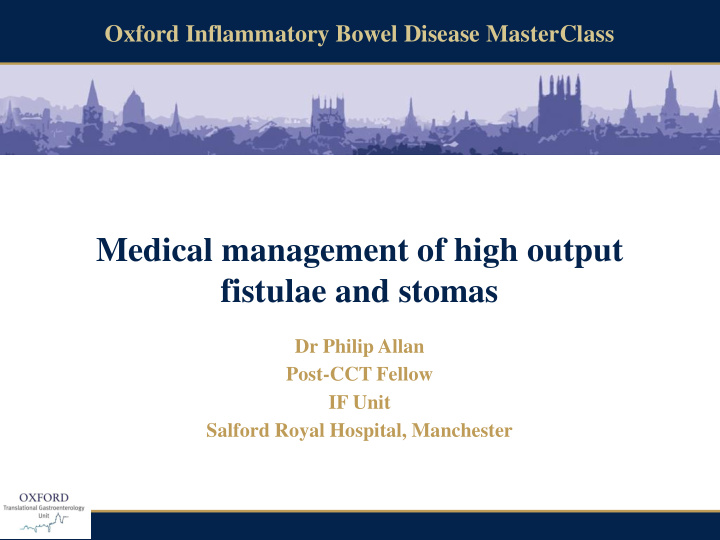



Oxford Inflammatory Bowel Disease MasterClass Medical management of high output fistulae and stomas Dr Philip Allan Post-CCT Fellow IF Unit Salford Royal Hospital, Manchester
Disclosures No disclosures
Workshop Objectives Review normal gut function Know the underlying aetiology of high output fistulae and stomas Review complications Know how to assess high output fistulae and stomas Treatment of high output fistulae and stomas
Intestinal fluid flux • 7-8 litres of fluid in upper gut • Most reabsorbed in jejunum & ileum (small intestine) • Need a high salt concentration to absorb water in the jejunum (90mmol/L) • 1.5-2 litres enters colon • 1.5-1.8L reabsorbed in colon • colon absorbs up to 4L/day if infused slowly • with an ileostomy, initial volumes are often 1500-1800mL until adaptation • Normally, 150-200mL excreted as stool • low salt, low water content 10% reduction in colonic absorption doubles the stool volume
Normal gut function Ileal effluent • Similar to cellular physiology • High sodium (140mM) • Low potassium (5mM) • High magnesium (1mM) Faecal effluent • Depends on colonic absorptive capacity • Low sodium(10mM) • High potassium (70mM) • Diarrhoea causes hypokalaemia Ileostomy (high output) • Hyponatraemia • Hyperkalaemia • Hypomagnesaemia • Biochemical picture of Addison’s High output stoma >1500mL/day Do NOT discharge patients High output fistula >500mL/day
Aetiology of High Output Fistulae and Stomas Who is at risk? Aetiology? Crohn’s patients Inflammatory burden Fistulating disease Dietary intake Ileostomy Small bowel maladaption Defunctioned Short bowel syndrome Permanent Entero-enterofistulae can Colectomy behave like high output UC Cancer stomas Vascular accidents Hypoalbuminaemia Other Operating <3-6/12 after last laparotomy
Assessment of High Output Stoma/Fistulae Review History Number of bag emptyings/night, associated pain, etc Request specialist dietician to review oral intake Type of fluid , quantity of drinks, food, etc Check current medication Doses of loperamide, omeprazole, lactose-containing medication
Consider cause of High Output Stoma/Fistulae Partial obstruction (parastomal hernia) Gastric acid hyper-secretion Bacterial overgrowth Pre-stomal ileitis (inflammation upstream of the stoma) Revealed latent disease (coeliac disease/ hypolactasia/ pancreatic disease/ pancreatic insufficiency/thyrotoxicosis) Infection (including ileal Clostridium difficile) Short bowel (surgical optimism on resected bowel length) Adaptation phase Uncontrolled inflammation, sepsis or malnutrition
Complications Dehydration/renal dysfunction Electrolyte abnormalities Renal Oxalate stones Psychological morbidity Death
Stoma and Fistulae investigations Measure volumes Urine sodium (>20mmol) Fluid balance Electrolytes (Na/K/Mg/Ca/PO4) Stoma Fistulae Examine stoma (exclude stomal Small bowel radiology (define stenosis with little finger) anatomy, exclude distal obstruction) Read op note (how much bowel Fistulogram is rarely helpful (defines left) a connection between skin and bowel) Small bowel radiology Cross sectional imaging Ileoscopy and biopsy MR pelvis Ileostogram Direct visualisation Cross sectional imaging (OGD/Colonoscopy, Ileoscopy) + biopsy
Fistula Treatment 1+2 Antibiotics for bacterial IF dietician overgrowth or sepsis Enteric feed depending on High dose PPI (switch off location and output gastric secretions) Fistuloclysis (occasionally Mega dose loperamide (16- possible for high fistula, 40-100mg/d) for high output long distal run off) Radiological drainage of TPN (if ECF output >500mL abscess if appropriate day and nutritional need) Stomatherapy to protect skin Nil by Mouth does not expedite healing!
Fistula Treatment 3+4 Define Anatomy (see earlier 60% close spontaneously slides) 90% conservative management by Treat medically and start 4-6/52 planning surgical intervention Albumin >30g/l necessary if medical treatment fails Albumin <30g/L usually = sepsis Address psychological support Wait (3-)6/12 after last laparotomy
High Output Stoma Treatment Step 1 IF dietician Dietary adjustment Isotonic fluids Omeprazole (80mg/d) Megadose Loperamide (16 - 40 - 100mg/day) Antibiotic trial for bacterial overgrowth
High Output Stoma Treatment Step 2 If output still >1500mL/d NBM 48hrs iv fluids to assess baseline output Review all investigations and management IF dietician and stomatherapist Monitor electrolytes (incl. Mg) daily If baseline output >1200mL then consider the need for iv fluids longterm
High Output Stoma Treatment Step 3 If output <1200mL… Commence oral rehydration solution trial 48hrs Na+>90mmol g/L mM/L
High Output Stoma Treatment Step 4 <1500 mL/24hrs after isotonics >1500 mL/24hrs after isotonics Go to Step 5 Sequential trial: Omeprazole 80mg/day + loperamide 8mg 4-5xday (can increase up to 100mg/d) + codeine 60mg 4xday + octreotide 3 x day Stop octreotide after 72hr if impact <300mL/d Output >1500mL Output <1500mL Plan longterm iv fluids/TPN Go to Step 5
High Output Stoma Treatment Step 5 Commence liquid feed (nutritional supplements) Measure effect on output >1500mL plan for TPN <1500mL go to Step 6
High Output Stoma Treatment Step 6 Start food and monitor effect on output
Treatment Summary High Output Stoma Management High Output Fistula Management SNAP 1. History/dietitian/investigate/ empirical therapy i. loperamide up to 100mg/d, omeprazole Sepsis 80mg/d, antibiotic trial 2. Measure basal output Nutrition 3. Impact of proper isotonics Anatomical assessment i. monitor output, should be <1500mL/d 4. Optimise medication and monitor Plan for surgery output 5. Add liquid feed and monitor output 6. Add solid food and monitor output 7. Decide on intravenous support i. fluids + magnesium, or nutrition
Workshop Objectives Review normal gut function Know how to assess high output fistulae and stomas Know the underlying aetiology of high output fistulae and stomas Review complications Medical management of high output fistulae and stomas
Recommend
More recommend